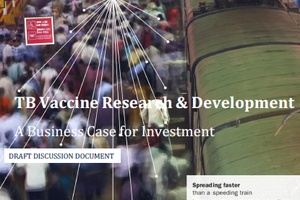TBVI, Aeras: TB vaccine business case: lifesaving TB vaccines feasible
Making new TB vaccines available to the world over the next 10-15 years is estimated to cost approximately €600 million, utilizing a highly efficient portfolio approach and adequate funding.
The global tuberculosis (TB) epidemic annually causes 1.4 million deaths and is estimated to cost the global economy €290 billion per year. Vaccines that could prevent people from acquiring, developing and transmitting disease would be the single most effective tool in mitigating this epidemic. Making new TB vaccines available to the world over the next 10-15 years is estimated to cost approximately €600 million, utilizing a highly efficient portfolio approach and adequate funding. This is presented in a business case, initiated by TBVI and developed in cooperation with Aeras, with the support of the European Investment Bank and the European Commission.
In 2011, an estimated 8.7 million people fell ill with active TB, with a third of those cases remaining both undiagnosed and untreated, confounding efforts to stop the spread of this deadly airborne disease (WHO, 2012). In addition, multi- and extensively drug-resistant TB threatens to halt overall progress. Like every other major infectious disease in the history of mankind, prevention through vaccination is the most cost-effective tool in eradicating and controlling this disease.
Investments of more than €450 million over the past decade have resulted in a robust global TB vaccine portfolio comprised of more than 25 early stage discovery leads and preclinical candidates, and more than a dozen candidates for which clinical trials are underway. But we are not there yet: another hundreds of millions of euros are needed to make new vaccines available for the market.
The current level and way of funding TB vaccine development will not be sufficient to develop the urgently needed new vaccines. Therefore as of 2009 TBVI initiated discussions with the European Commission and European Investment Bank to find new innovative ways of funding. This resulted in a resolution of the European Parliament on 3 February 2011 to support TBVI. This was followed by the first innovative funding plan, developed by TBVI, which was a complete new way of thinking about funding new tools against poverty related diseases like tuberculosis.
In the past two years TBVI started collaborations with Aeras to further evolve this plan. With strong support from the European Investment Bank and The European Commission a new ‘Business Case for Investment in TB vaccines’ was developed. This (draft) business case demonstrates that a viable global market exists for new TB vaccines, although formerly perceived as being of little significance, as TB is mainly a poverty related disease. The document shows that it is possible develop new vaccines for the market based on the current worldwide available vaccine candidates, at cost of approximately €600 million. An important condition is that effective global portfolio approach is necessary. This can be achieved by applying rigorous stage-gating criteria and innovative trial designs that facilitate the expeditious down-selection of candidates. The scarce resources have to be preserved by advancing only the most promising candidates into the more expensive, later-stage trials. Besides that, efficient use of available finance of public and private origin is necessary, and additional funds are needed.
The draft business case is currently being discussed with current and potential new funders: governments, foundations, industry and private donors. After all only global collaboration can turn this business case into reality. Making new TB vaccines available to the world is estimated to cost approximately €600 million. These costs pale in comparison to the estimated €6 billion a year required to provide TB treatment and care. While no one should be denied access to life-saving treatment today, austerity measures demand that we invest in longer-term strategies that could ultimately save billions in treatment costs while protecting future generations from one of the longest lasting and deadliest epidemics of mankind.


